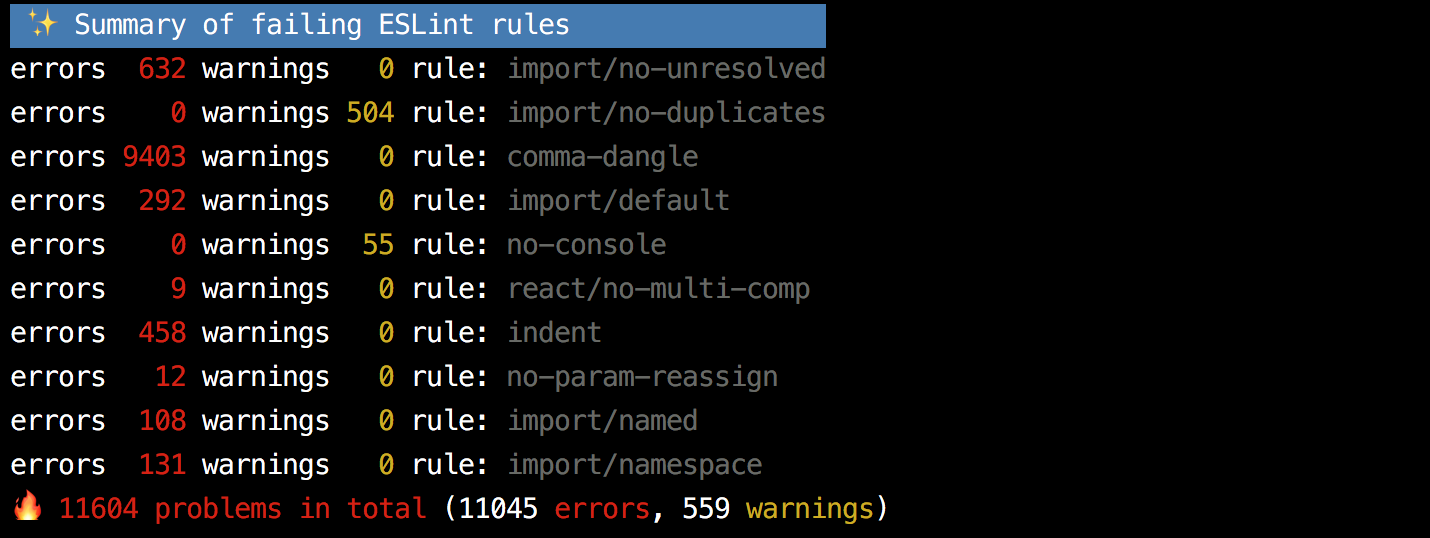eslint-formatter-summary
ESLint formatter aggregating results by rule
Features
- aggregated errors / warnings per rule
- sort by rule name, number of errors or warnings
TL;DR
This formatter simply aggregates the ESLint results by rule and shows the following output:
It can also be configured to sort results by rule, errors or warnings using env vars e.g.
SORT_BY=rule DESC=true eslint -f summary ./src(see details below).
How to install
If you're using yarn just run
yarn add -D eslint-formatter-summaryotherwise with npm run
npm i --save-dev eslint-formatter-summaryHow to use
When you run ESLint just specify eslint-formatter-summary as the formatter:
eslint -f summary [file|dir|glob]*or if you use an older version of ESLint:
eslint -f node_modules/eslint-formatter-summary [file|dir|glob]*See http://eslint.org/docs/user-guide/command-line-interface#-f---format
Intention
It is a matter of minutes to add ESLint to a new project, however it can be quite challenging to introduce it (or just add a stricter rule set) to existing projects, already large codebases.
Possibly hundreds if not thousands of errors will pop up which can seem overwhelming to be fixed when we see the default formatted output, forcing us to back up from making our code base better / more consistent.
This package provides a custom ESLint formatter to help in these situations to make the right decisions by showing the linting results aggregated by rule. It gives an overview of all rules failing showing the total number of errors and warnings summed up by rule.
Having this summary overview can give us the opportunity e.g. to consider suppressing certain rules for now and bringing them back in later when we are ready to fix them.
Output format
With the default ESLint formatter you might get several thousands of lines of failing rules in various files in the output e.g.:
The Summary Formatter simply aggregates the ESLint results by rule and shows the following output instead:
In the above example we can notice that the comma-dangle rule is responsible for about 2/3 of the failures, so we can consider turning it off or just suppressing it to a warning for now as we can do so with the other failing rules.
Sorting output
Default sorting is by
rulein anascendingorder
Configuration options can be passed to the formatter to alter the output.
Using theSORT_BY env var the aggregated results can be sorted by either rule, errors or warnings e.g.
SORT_BY=rule eslint -f summary ./srcthe sorted results are shown in ASCENDING order by default but the order can also be reversed using DESC=true:
SORT_BY=rule DESC=true eslint -f summary ./srcSupported Node versions
The project came alive with the specific intention to support all Node.js version from v4.x as this formatter is supposed to be an enabler for most projects and does not want to stand in the way by supporting only the latest Node.js versions.
Supported Node.js versions are the latest:
- latest stable
- v4 to LTS
The distribution version targets Node.js v4 and should work on this version and above.
Supported ESLint versions
ESLint versions are supported from v4 onwards, although eslint-formatter-summary may also work with lower versions of ESLint. Please open an issue if you need support for other versions of ESLint.
Contribute
Please feel free to submit an issue describing your proposal you would like to discuss. PRs are also welcome!
Install dependencies
yarn
Run unit tests
yarn test
Change code
The project's code is written using the latest EcmaScript standard's features, some of which needs to be polyfilled in older Node.js versions e.g. Array.prototype.includes and String.prototype.padLeft etc., for that core-js is being used.
When changing code, you might want to run unit tests and re-build the project on file changes:
yarn test --watch
and
yarn dev
Build project
yarn build
This will use babel-cli to transpile the source code targeting node v4 (the lowest supported Node.js version) to dist folder.
The transpiled code is generated under the dist/ folder and it is the one used to generate the summary output of ESLint rather than the original ES7+ source code under lib/.
Test build project
Once the project is built the distribution version can be tested via passing a .js file to yarn try.
For example:
yarn try test.js
CI build
The project is built on Travis-ci.org targeting each supported Node.js versions (see the list above).
During the CI build all source files are linted and all unit tests need to pass resulting in a coverage report.
Publishing new versions
The project uses semantic versioning.
patch versions are used to fix bugs and upgrade dependencies. minor versions are used to add new non-breaking features. major version is bumped when there are significant changes which could break projects already using eslint-formatter-summary.
To publish a new version we use np
yarn release 1.2.3
See https://github.com/sindresorhus/np for more options.
Possible improvements / planned features
- test formatter with different Node.js and ESLint versions on CI
- allow different output showing files with aggregated number of errors / warnings
- export results as JSON
- export each rule turned off and ready to be added to
.eslintrc
License
MIT




